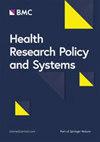Mapping the way: functional modelling for community-based integrated care for older people
IF 3.6
2区 医学
Q1 HEALTH POLICY & SERVICES
引用次数: 0
Abstract
Healthcare system sustainability is challenged by several critical issues; one of the most pressing is the ageing population. Traditional, episodic care delivery models are not designed for older people who are medically complex and frail. These individuals would benefit from health and social care that is more comprehensive, coordinated, person-centred and accessible in the communities in which they live. Delivering this is a challenging endeavour. Community-based health and social care professionals are siloed, dispersed across various locations and sectors, each with their own mental models, electronic health information systems, and means of communication. To move away from fragmented care delivery models and towards a more integrated approach to care, an analysis of the process of community-based comprehensive geriatric assessment was conducted in an urban location in Atlantic Canada. The purpose of the study was to identify where in the community-based comprehensive geriatric assessment process challenges and opportunities existed for moving towards a more integrated model of care delivery. The functional resonance analysis method (FRAM) and dynamic FRAM (DynaFRAM) modelling were used to model the community-based health and social care system and create a hypothetical patient journey scenario. Data collected to inform modelling consisted of document review, focus groups, and semi-structured interviews with health and social care professionals providing care and service to older people in the community setting. Challenges and opportunities for implementing integrated care in the local context were identified. Findings from the FRAM and DynaFRAM analysis informed the co-design of multi-level process improvement recommendations that aim to move the local community-based comprehensive geriatric assessment process towards a more integrated model of care. A transformative redesign of community-based health and social care in the local context is necessary but cannot be accomplished without an understanding of how health and social care professionals conduct their work and how older people may receive care under the dynamic conditions. The FRAM and DynaFRAM modelling provided an enhanced understanding of system operations and functionality and demonstrated a critical step that should not be overlooked for decision-makers in their efforts to implement a more integrated model of care.绘制路线图:老年人社区综合护理功能模型
医疗保健系统的可持续发展面临几个关键问题的挑战,其中最紧迫的问题之一就是人口老龄化。传统的、临时性的医疗服务模式并不适合病情复杂、身体虚弱的老年人。这些人将受益于更全面、更协调、更以人为本、更方便的医疗和社会服务。实现这一目标是一项具有挑战性的工作。以社区为基础的医疗和社会护理专业人员各自为政,分散在不同的地点和部门,每个人都有自己的心理模式、电子医疗信息系统和通信手段。为了摒弃各自为政的护理模式,采用更加综合的护理方法,我们在加拿大大西洋沿岸的一个城市对社区老年综合评估的过程进行了分析。研究的目的是确定社区老年病综合评估过程中存在哪些挑战和机遇,以便向更综合的护理服务模式转变。研究采用功能共振分析法(FRAM)和动态功能共振分析法(DynaFRAM)建模,对社区医疗和社会护理系统进行建模,并创建一个假设的病人旅程场景。为建立模型而收集的数据包括文件审查、焦点小组以及与在社区环境中为老年人提供护理和服务的医疗和社会护理专业人员进行的半结构化访谈。确定了在当地实施综合护理所面临的挑战和机遇。根据 FRAM 和 DynaFRAM 分析的结果,共同设计了多层次的流程改进建议,旨在将当地的社区老年综合评估流程转变为更加综合的护理模式。对当地社区医疗和社会护理进行变革性的重新设计是必要的,但如果不了解医疗和社会护理专业人员是如何开展工作的,以及老年人在动态条件下是如何接受护理的,就无法实现这一目标。FRAM 和 DynaFRAM 建模增强了对系统运作和功能的了解,并展示了决策者在努力实施更加综合的护理模式时不应忽视的关键步骤。
本文章由计算机程序翻译,如有差异,请以英文原文为准。
求助全文
约1分钟内获得全文
求助全文
来源期刊

Health Research Policy and Systems
HEALTH POLICY & SERVICES-
CiteScore
7.50
自引率
7.50%
发文量
124
审稿时长
27 weeks
期刊介绍:
Health Research Policy and Systems is an Open Access, peer-reviewed, online journal that aims to provide a platform for the global research community to share their views, findings, insights and successes. Health Research Policy and Systems considers manuscripts that investigate the role of evidence-based health policy and health research systems in ensuring the efficient utilization and application of knowledge to improve health and health equity, especially in developing countries. Research is the foundation for improvements in public health. The problem is that people involved in different areas of research, together with managers and administrators in charge of research entities, do not communicate sufficiently with each other.
 求助内容:
求助内容: 应助结果提醒方式:
应助结果提醒方式:


